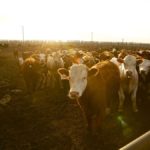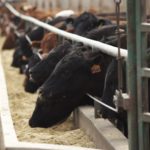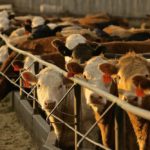Wholesale beef values have experienced a significant rally over the past couple of weeks, which has spilled over into the fed cattle trade. Alberta packers were buying fed cattle at $274 on a dressed basis, up $2-$4 from week-ago levels. Despite the strength in the fed cattle and healthy margin structure, Western Canadian feeder cattle […] Read more

Klassen: Seasonal strong beef demand supports feeder market

Klassen: Healthy margins drive feeder complex
Western Canadian feeder cattle markets traded steady to $5 higher compared to week-ago levels. Buyers were quite meticulous on flesh levels and quality features in the heavier weight categories; however, feedlot operators were definitely more aggressive this week. Major operations have liquidated a fair amount of fed cattle and these players are anxious to reload […] Read more
Understanding feeder cattle risk: Pt. 2
Market Update with Jerry Klassen: You don’t want to be using marketing tools to lock in a loss
The feeder cattle market has experienced extreme volatility over the past three years. For this reason, I’ve been writing on managing financial risk for feeder cattle and particularly for backgrounding operations and cow calf producers. In the first column, I discussed the mechanics of hedging, explained historical basis levels and using these basis levels to […] Read more

Klassen: Feeder cattle drop on cautious feedlot demand
Western Canadian feeder cattle markets traded $3 to as much as $8 below week-ago levels as feedlot managers anticipate growing beef supplies during the late spring and summer. Heavier weight categories absorbed the brunt of the selling pressure, with backgrounding operators liquidating fall-placed calves. Certain groups of higher-quality heifers held value with the purpose of […] Read more
Understanding feeder cattle risk: Pt. 1
Market Update with Jerry Klassen: A hedging program can remove some of the uncertainty
In the January 24 Grainews issue, I explained the feeder cattle futures market and the simple mechanics of hedging feeder cattle. In this column, I want to take one step further and discuss the financial risk associated with backgrounding or selling feeder cattle. Read more: Important to understand the futures Read more: Producers hit with […] Read more

Klassen: Tenacious feeder market softens on supply forecasts
Western Canadian feeder cattle prices traded steady to as much as $5 lower over the past week. Early in the week, buyers incorporated a risk discount due to the extremely cold temperatures, especially in the Eastern prairie regions. By Thursday, markets were factoring in the larger beef supply forecasts from the U.S. Department of Agriculture, […] Read more
Short-term gains, long-term pains
The market still needs to discourage beef production — and that hurts
Fed and feeder cattle prices have been percolating higher recently as the markets adjust to lower-than-expected first-quarter beef production. Alberta fed cattle prices have been hovering in the range of $162 to $165, which is approximately $25 above break-even pen closeout values. Healthy feedlot margins allowed feedlots to bid up feeder cattle prices. Larger-frame steers […] Read more

Klassen: Feeder cattle markets digest USDA inventory report
Western Canadian feeder cattle markets traded $5 higher to as much as $10 lower compared to week-ago levels. The U.S. Department of Agriculture’s Cattle on Feed report, along with U.S. inventory data, confirmed larger beef supplies in upcoming months, which set a negative sentiment amongst feedlot operators. Auction markets experienced variable price ranges on similar-weight […] Read more

Klassen: Fed cattle uncertainty restricts upside in feeders
Western Canadian feeder cattle were actively trading $3-$5 higher compared to week-ago levels. Order buyers felt like they were groping in the dark but realized there was a fair amount of buying interest by the week’s end. Alberta and Ontario orders were floating aggressively into Manitoba and eastern Saskatchewan, which kept the market flat across […] Read more
Important to understand the futures
Market Update: Learn to use hedging tools when selling calves
Over the past year, I’ve received many inquiries from cow-calf producers about hedging feeder cattle. Most producers calve during the winter or spring and sell their feeders in the fall or the following winter after backgrounding. We’ve all seen how the prices can change within a six- to 10-month period. One of the most common questions I […] Read more


